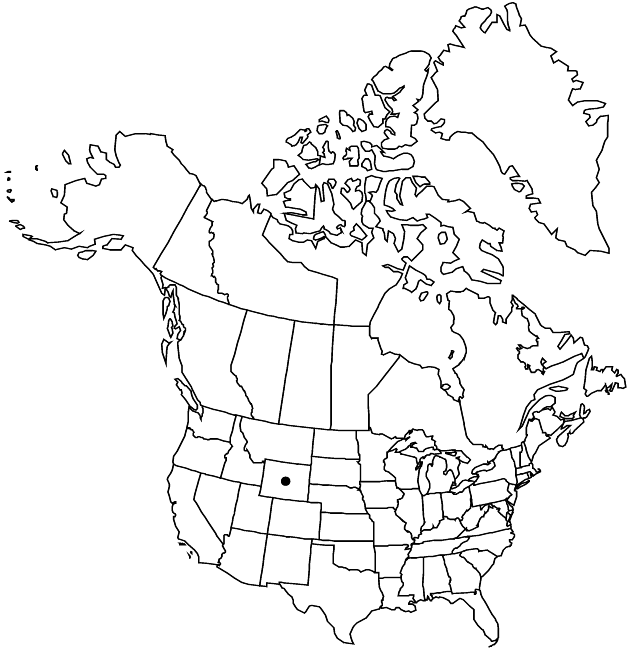Difference between revisions of "Heterotheca villosa var. depressa"
Novon 4: 53. 1994.
FNA>Volume Importer |
FNA>Volume Importer |
||
| Line 7: | Line 7: | ||
|year=1994 | |year=1994 | ||
}} | }} | ||
| − | |basionyms={{Treatment/ID/ | + | |basionyms={{Treatment/ID/Basionym |
|name=Chrysopsis depressa | |name=Chrysopsis depressa | ||
|authority=Rydberg | |authority=Rydberg | ||
| + | |publication_title=Mem. New York Bot. Gard. | ||
| + | |publication_place=1: 381. 1900 | ||
}} | }} | ||
|synonyms={{Treatment/ID/Synonym | |synonyms={{Treatment/ID/Synonym | ||
| Line 30: | Line 32: | ||
|distribution=Wyo. | |distribution=Wyo. | ||
|discussion=<p>Of conservation concern.</p><!-- | |discussion=<p>Of conservation concern.</p><!-- | ||
| − | --><p>Variety depressa grows in geyser basins in Yellowstone National Park and is locally common in rocky soils in Teton National Park; it is very rare farther south in Wyoming. It is distinguished by its small stature, small heads, and linear-oblanceolate leaves with many hairs and usually some glands. It is similar to some forms of <i></i>var.<i> minor</i>, which occur throughout the range of <i></i>var.<i> depressa</i> and with which it hybridizes. It is also similar to hairier forms of <i></i>var.<i> villosa</i>. Typical <i></i>var.<i> depressa</i> occupies the vicinity of hot springs and geyser basins and nearby river flood banks, while <i></i>var.<i> minor</i> occupies other drier or non-geyserite nearby habitats.</p> | + | --><p>Variety depressa grows in geyser basins in Yellowstone National Park and is locally common in rocky soils in Teton National Park; it is very rare farther south in Wyoming. It is distinguished by its small stature, small heads, and linear-oblanceolate leaves with many hairs and usually some glands. It is similar to some forms of <i></i></i>var.<i><i> minor</i>, which occur throughout the range of <i></i></i>var.<i><i> depressa</i> and with which it hybridizes. It is also similar to hairier forms of <i></i></i>var.<i><i> villosa</i>. Typical <i></i></i>var.<i><i> depressa</i> occupies the vicinity of hot springs and geyser basins and nearby river flood banks, while <i></i></i>var.<i><i> minor</i> occupies other drier or non-geyserite nearby habitats.</p> |
|tables= | |tables= | ||
|references= | |references= | ||
| Line 54: | Line 56: | ||
|publication year=1994 | |publication year=1994 | ||
|special status= | |special status= | ||
| − | |source xml=https://jpend@bitbucket.org/aafc-mbb/fna-data-curation.git/src/ | + | |source xml=https://jpend@bitbucket.org/aafc-mbb/fna-data-curation.git/src/f6b125a955440c0872999024f038d74684f65921/coarse_grained_fna_xml/V19-20-21/V20_548.xml |
|tribe=Asteraceae tribe Astereae | |tribe=Asteraceae tribe Astereae | ||
|genus=Heterotheca | |genus=Heterotheca | ||
Revision as of 19:43, 24 September 2019
Stems ascending to erect, 5–22 cm, moderately to densely hispido-strigose, sparsely long-hirsute, eglandular or sparsely stipitate-glandular. Distal cauline leaf blades linear-oblanceolate, 5–19(–23) × 2.3–4.2(–4.7) mm, sometimes little reduced, bases cuneate to attenuate, margins flat, apices acute, faces densely strigose (hairs 84–140/mm2), sparsely to to moderately stipitate-glandular (glands 0–28/mm2). Heads 1–8(–10) in congested to open corymbiform arrays. Peduncles (7–)12–28(–37) mm, moderately to densely hispido-strigose, eglandular or sparsely stipitate-glandular; bracts subtending heads small or none. Involucres cylindric to narrowly campanulate (fresh), 5.5–6.8(–7.5) mm. Phyllaries lanceolate to narrowly triangular-lanceolate, margins often reddish purple distally, faces moderately to densely strigose, eglandular or sparsely stipitate-glandular. Ray florets 5–13(–15); laminae 5–9.5(–11) mm. 2n = 36.
Phenology: Flowering (Jun–)Jul–Sep(–Nov).
Habitat: Hot springs, broken travertine on old terraces, dry geyserite, gravelly stream banks, dry rocky hillsides, open slopes, dry sandy soils, montane conifer forests
Elevation: 1800–2400 m
Discussion
Of conservation concern.
Variety depressa grows in geyser basins in Yellowstone National Park and is locally common in rocky soils in Teton National Park; it is very rare farther south in Wyoming. It is distinguished by its small stature, small heads, and linear-oblanceolate leaves with many hairs and usually some glands. It is similar to some forms of var. minor, which occur throughout the range of var. depressa and with which it hybridizes. It is also similar to hairier forms of var. villosa. Typical var. depressa occupies the vicinity of hot springs and geyser basins and nearby river flood banks, while var. minor occupies other drier or non-geyserite nearby habitats.
Selected References
None.
